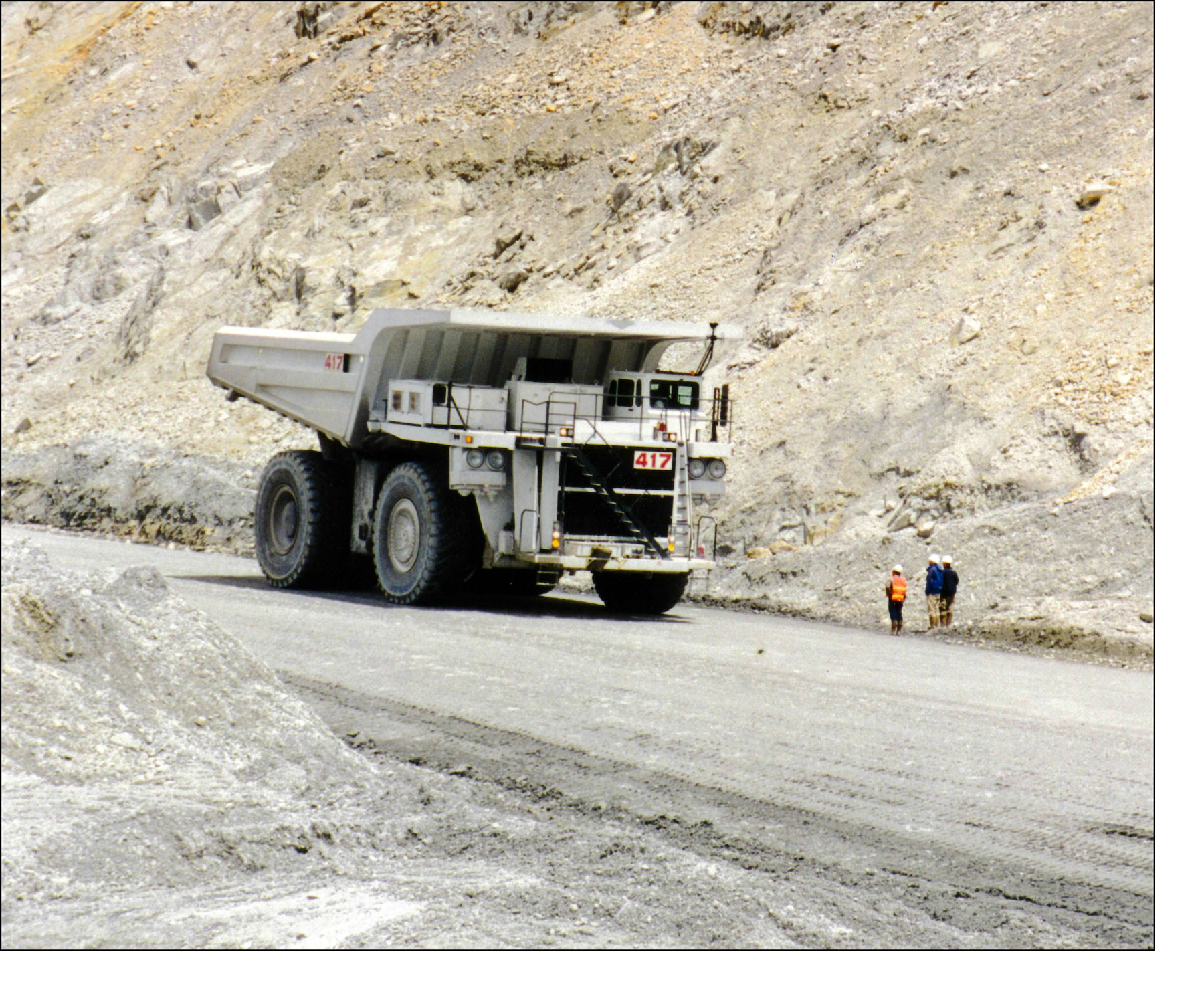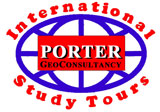| |||||||||||
|
Super Porphyry 2003-04 The Super Porphyry Cu/Au Deposits of the World October 2003 & April-May 2004 | |||||||||||
|
| |||||||||||

Porter GeoConsultancy continued its International Study Tour series of professional development courses by visiting a representative selection of the world's key super porphyry copper/gold deposits as two separate, compact modules six months apart in October 2003 and April-May 2004 respectively.
The first module, in 2003, commenced in Santiago, Chile, on the evening of Saturday 11 October and ended just over 14 days later in Lima, Peru, early on the morning of Sunday 26 October. It commenced with a field workshop, and then visited ten of the most important Andean porphyry deposits/mineralised systems in the two countries, representing the different styles/ages of mineralisation, spread over the interval from near Santiago in the south, to northern Peru. Module 2, in 2004, ran from the evening of Friday 23 April when the group assembled in Ulaanbaatar, Mongolia, until completed on the afternoon of Tuesday 11 May in Orange, New South Wales, Australia. It took in six major deposits from the Central Asian Orogenic Belt and the western Pacific margin, in Mongolia, China, Indonesia and Australia. The visits in Australia were supported by a field workshop. Participants were able to take any 5 or more days, up to a full module/tour, as suited their interests or availability, joining and leaving the tour at appropiate locations along the route. Visits involved detailed presentations, generally covering the geology, alteration, mineralisation, geophysical expression and discovery of the deposit, followed by the opportunity to study the mineralisation and hosts exposed in the mine and/or the field, as well as viewing representative drill core intersections through the deposit.
The countries/regions and deposits visited were as follows:
Chile, • Field Workshop - a full day geological traverse across the central Andes near Santiago was conducted by well known Chilean expert Estanislao Godoy of Sernageomin-Chile to illustrate the geological and tectonic setting of the segment of the Cordillera hosting super porphyries in central Chile and provide a regional context to the deposits to be visited in the following days, Sunday 12 October, 2003. • Los Bronces - Rio Blanco, one of a cluster of giant Miocene breccia/porphyry Cu-Mo deposits to the east of Santiagio in central Chile. Mineralisation occurs in the matrix of breccia pipes of the 7.4 to 5.4 Ma Rio Blanco Breccia Complex, younger 5.9 to 5.1 Ma tourmaline rich breccia pipes, the host Miocene to early Pliocene porphyry intrusions and Oligocene to Miocene andesite lavas surrounding the breccias, Monday 13 October, 2003. • Los Pelambres is the northern-most of the trio of giant Miocene to Pliocene porphyry style Cu-Mo deposits of Central Chile, and is located on the Chile-Argentine border, some 150 km north of Los Bronces. Mineralisation occurs as quartz stockwork veining associated with early potassic alteration and breccia pipes, and as late pyrite veining with sericite halos, Monday 26 to Tuesday 27 April, 2004. • El Teniente the southernmost of the trio of giant late Miocene to Pliocene porphyry Cu-Mo deposit of central Chile, emplaced in multiple telescoped magmatic-hydrothermal biotite, anhydrite and tourmaline breccias, hosted by pervasively biotite altered middle Miocene mafic intrusive and extrusive rocks comprising gabbros, dolerites, porphyritic basalts and basaltic andesites, Wednesday 15 October, 2003. • Escondida & Zaldivar, two of a cluster of related deposits within an area of 12 x 6 km, ~160 km to the ESE of Antofagasta in northern Chile, and within the 50 km wide Domeyko Fault System. Both are associated with the second of the three main hypogene mineralising events of the cluster which were at ~41, 38 to 36 and 36 to 34 Ma during the Eocene. Escondida is principally an up to 400 m thick supergene sulphide blanket, between an up to 400 m thick leached cap, and an underlying, lower grade hypogene sulphide deposit. At Zaldiva, a similar leached cap passes down into a thick supergene oxide copper zone and a lower secondary sulphide enrichment, grading down via a mixed zone into hypogene sulphides, Thursday 16 October, 2003. • Chuquicamata, a porphyry Cu-Mo deposit, ~220 km north of Escondida, associated with the Late Eocene 36 to 33 Ma Chuqui Porphyry Complex intruding Palaeozoic meta-granitoids and Mesozoic volcanic and sedimentary rocks. The intrusive complex is juxtaposed with barren Mesozoic intrusions to the west by the West Fissure. To the east of this structure, an early linear, north-south zone of strong quartz-K feldspar alteration marks the main bornite-digenite core, which grades progressively eastward into bornite-chalcopyrite to chalcopyrite-pyrite and a barren propylitic periphery. Adjacent to the West Fissure, this zoning is over-printed by the younger pyrite-chalcopyrite-bornite-digenite main stage veins, accompanied by pervasive quartz-sericite alteration, Friday 17 October, 2003. • Spence, is a major porphyry Cu-Mo deposit ~65 km SW of Chuquicamata in northern Chile. It is associated with an Upper Paleocene, ~57 Ma, complex of granodioritic to quartz-monzonite stocks intruded into an upper Jurassic to lower Cretaceous suite of largely andesitic volcanic rocks. Mineralisation is entirely masked by 50 to >100 m of gravel that overlies a leached cap, a zone of supergene oxides, an enriched chalcocite blanket and then via mixed sulphide zones to low grade hypogene mineralisation. In 2003, the deposit was un-mined, with the original surface undisturbed, other than a box cut through cover and leached capping to a test decline into ore Saturday 18 October, 2003. • El Salvador in the Indio Muerto district of Northern Chile, some 200 km south of the Escondida. The district comprises the main 6 km long El Salvador/Turquoise Gulch cluster of supergene enriched and hypogene porphyry Cu-Mo deposits and the related Damiana exotic Cu accumulation, as well as the Potrerillos porphyry copper ores 25 km to the north. Mineralisation was emplaced in two stages in the Eocene, an initial 44 Ma phase and a later, more important 42 to 41 Ma pulse. The district has been the focus of studies that have influenced the understanding porphyry Cu deposits, Monday 20 October, 2003. • Collahuasi, comprises two large porphyry copper deposits, Ujina and Rosario, which are 7 km apart in northern Chile, ~150 km north of Chuquicamata. Two other deposits, the down-faulted La Profunda to the east of Ujina, and Quebrada Blanca, 8 km to the WSW of Rosario complete the near 25 km long, broadly east-west aligned cluster that are associated with three separate 35 to 33 Ma, Eocene to Oligocene mineralised intrusive complexes. All lie within a block of upthrown Permo-Triassic volcano-sedimentary rocks between two major north-south faults related to the Domeyko Fault System that also embraces the Escondida and Chuquicamata deposits. Two main stages of hypogene porphyry-style mineralisation and alteration are recognised at Ujina, an early K feldspar-biotite alteration with quartz-chalcopyrite-bornite, progressing to quartz-molybdenite, and a late or Main stage of pyrite-chalcopyrite-quartz veining surrounded by phyllic envelopes. At Rosario, a similar suite is overprinted by high-sulphidation epithermal Cu-Ag style mineralisation culminating in tennantite-enargite veining, Tuesday 21 October, 2003. Peru • Cuajone, which with Toquepala and Quellaveco, form a trio of major Paleocene to early Eocene, 56 to 42 Ma, porphyry Cu-Mo deposits spread over a NW trending 30 km, interval of southern Peru. Mineralisation and alteration is associated to a 2.5 x 0.7 km, NW-SE elongated, multistage latite porphyry intruding basaltic andesites and overlying rhyolite porphyries of the 80 to 65 Ma Toquepala Group, underlain by Precambrian metamorphics of the Arequipa Massif, Thursday 23 October, 2003. • Antamina, a Miocene porphyry/skarn Cu-Zn deposit associated with a 9.8 Ma composite core intrusion in the western Cordillera of northern Peru. It is an oxidised Cu-rich garnet-pyroxene calcic skarn with an anomalously high grade outer Zn-rich shell, developed in the carbonate wall rocks of a low grade calc-alkaline porphyry Cu-Mo mineralised quartz-monzonite porphyry core, Saturday 25 October, 2003.
Mongolia, • Erdenet, a porphyry Cu-Mo deposit in northern Mongolia associated with the Triassic to Lower Jurassic Erdenet Magmatic Complex, that is related to continental collision between the Siberian craton and the Mongolian-North China blocks, Saturday 24 & Sunday 25 April, 2004. • Oyu Tolgoi, a narrow, 12 km long, almost continuous linear cluster of Late Devonian, telescoped high sulphidation and porphyry copper-gold-(molybdenum) mineralisation in the Central Asian Orogenic Belt, located in the Gobi Desert of southern Mongolia, ~80 km north of the Chinese border. Mineralisation is associated with multiple, overlapping, intrusions of Late Devonian (~372 to 370 Ma) quartz-monzodiorite that are chronologically indistinguishable from the basaltic to dacitic pyroclastics of the upper Oyu Tolgoi sequence, into which they partially intrude, Monday 26 to Tuesday 27 April, 2004. China • Dexing - three large Mid Jurassic porphyry Cu-Mo-Au deposits, Tongchang, Fujiawu and Zhushahong that define an 8 km long, NW-SE trending corridor cutting across the NE-SW Mesozoic intra-continental rift separating the Yangtze Craton and Cathaysia Block in southeastern China, Wednesday 28 & Thursday 29 April, 2004. Indonesia • Batu Hijau, a Miocene-Pliocene porphyry Cu-Au deposit associated with the Sunda-Banda magmatic arc at the convergent margin between the Australian-Indian and Eurasian plates. It is located on south-western Sumbawa Island in central Indonesia, Sunday 2 to Tuesday 4 May, 2004. • Grasberg and Ertsberg - a diverse cluster of giant Pliocene porphyry and skarn copper-gold deposits in West Papua, intruding a carbonate sequence in the core of the Papuan Fold Belt that forms the spine of the island of New Guinea. The district incorporates the super-giant Grasberg porphyry deposits associated with the 3.2 to 2.7 Ma Grasberg Igneous Complex, porphyry ores of the 4.4 to 3.0 Ma Ertsberg Diorite 2.5 km to the south, and a series of skarn deposits surrounding the latter and between the two intrusive complexes, Wednesday 5 to Friday 7 May, 2004. Southeastern Australia • Field Workshop - to provide an overview of the geological setting of porphyry copper and gold mineralisation in the eastern Lachlan Fold Belt of New South Wales. The workshop commenced with an expert briefing in Sydney by Dr Dick Glen of the NSW Department of Mineral Resources outlining the tectonic, geologic and metallogenic framework of the Lachlan Fold Belt and the porphyry copper and gold mineralisation it hosts, particularly that segment that embraces the Cadia and Northparkes mines. A forty five minute flight after the briefing, held at a venue near Sydney airport, took the group the city of Orange and direct into the field. The field component of the workshop was hosted by Max Rangott of Rangott Mineral Exploration and comprised visits to exposures that demonstrated the basic elements of the region's geology, particularly the lithologies/units that host ore, both proximal to/within and removed from mineralisation, Monday 10 May, 2004. • Cadia Valley Operations (CVO) - a cluster of gold dominant porphyry gold-copper deposits hosted by an Ordovician shoshonitic volcano-intrusive centre of the Lower Palaeozoic Macquarie Arc, in New South Wales, Tuesday 11 May, 2004. The full tour involved over 21 000 km of travel, with the long distances between sites in most cases requiring a separate travelling day. This was compensated at a number of locations with two days on site. The remote settings of most deposits required charter aircraft and helicopter flights, as well as sea transits and charter minibus transport, in addition to the long commercial airline flights, an number of which were overnight. The tour was planned, organised, managed and escorted by Mike Porter of Porter GeoConsultancy Pty Limited. | |||||||||||
| |||||||||||
|
| |||||||||||












